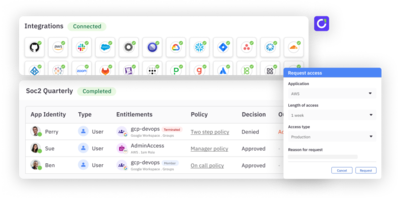Identity and access management (IAM) is a cybersecurity practice that involves managing and controlling access to digital resources within an organization. IAM solutions typically include tools and processes for managing user identities, defining access policies, and enforcing access controls.
IAM solutions provide a framework for organizations to manage user access to critical systems, applications, and data. Identity and access management is particularly important for organizations that deal with sensitive data, such as financial institutions, healthcare providers, and government agencies. The primary goal of IAM is to minimize risk of unauthorized access and data breaches through the management of who has access when.
In addition to improving security, IAM can also provide operational benefits, such as reducing the workload of IT staff and improving the efficiency of access management processes. IAM tools can automate IAM tasks, such as the provisioning and deprovisioning of user access, and can help organizations streamline their operations and reduce the risk of errors and inconsistencies in access management policies and workflows.
What are IAM solutions?
IAM solutions are software tools that help organizations manage and control access to their systems, applications, and data based on users’ identities and roles within the organization. These solutions provide a range of features and capabilities that help organizations strengthen security posture and comply with regulatory requirements.
Some common features of identity access management systems include:
- Authentication: Verifying the identity of a user before granting access to systems or data. This can be done through a variety of authentication methods, such as passwords, biometrics, or multi-factor authentication (MFA).
- Authorization: Determining what level of access a user can have to resources based on their identity and job title and function. This is typically done through role-based access control (RBAC), where users are assigned to specific roles that determine what resources they can access.
- Administration: Managing user accounts, roles, and permissions, including the creation, modification, and deletion of user accounts and the assignment of roles and permissions.
- Auditing and reporting: Tracking and monitoring the activity of individual users to ensure compliance with security policies and regulatory compliance requirements, as well as providing detailed reports on user access and activity.
- Single sign-on (SSO): Allowing users to access multiple apps and systems using a single set of credentials, making it easier to manage and control user access.
IAM systems can be deployed on-premises or in the cloud and can be tailored to meet the specific needs and requirements of an organization.
Use cases for IAM solutions
IAM solutions can help fulfill several initiatives across cybersecurity, business operations, and other verticals. These include:
- Digital transformation: With the rise of multi-cloud environments, remote work, and technologies like artificial intelligence, companies need to secure access across multiple locations and ensure that only authorized users have the necessary access to critical resources by centralizing access management for individual users and resources.
- IT management and network administration: IAM systems allow users to access multiple resources with one single digital identity instead of creating different accounts for each service. This reduces the volume of user accounts IT teams have to manage. IAM systems also streamline the process of assigning access rights by implementing control models such as RBAC.
- Network and data security: According to anIBM study, credential theft is the leading cause of data breaches within companies today. Overprivileged accounts are a main target for these breaches, serving as vectors for hackers to gain access to sensitive data. IAM systems add extra layers of user authentication, mitigating vulnerabilities and preventing lateral movement to ensure that even if bad actors breach your systems, they will not get very far.
- Regulatory compliance: Many standards such as GDPR, HIPAA and SOX require strict policies around who can access sensitive data and for what purposes. By following the principle of least privilege, IAM systems allow organizations to enforce strict access policies and ensure that users only have access to the necessary data needed to carry out their job functions. Companies can also track user activity and access levels to prove compliance during an audit.
What are the benefits of IAM?
One of the key benefits of implementing IAM is that it provides a granular level of control over user access. This means that access can be granted or denied based on specific needs and job functions, rather than granting blanket access to all users. This can help to reduce security risk of data breaches caused by human error or malicious activity.
IAM also enables organizations to manage user access across multiple systems and applications from a centralized location. This provides scalability, flexibility, and cost-effectiveness, making it a great choice for businesses of all sizes. With IAM, organizations can streamline the management of user accounts, roles, and permissions, making it easier to control and secure access across multiple systems and applications.
Another benefit of IAM is that it provides a detailed audit trail of user activity. This makes it easier to investigate security incidents and take appropriate action, and also helps organizations to meet compliance requirements by providing evidence of user activity.
Summary
IAM is an essential practice for any organization that values data protection and compliance. By managing access to resources based on user identities and roles, organizations can protect against cyber threats and ensure that sensitive information remains secure. With the rise of cloud-based SaaS solutions, IAM is becoming more accessible and cost-effective for businesses of all sizes. Effective IAM requires a holistic approach that encompasses people, processes, and technology, and should be a key component of any organization’s security strategy.


